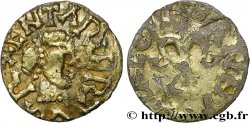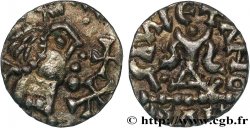bmv_228024 - MEROVINGIAN COINAGE - BANASSAC (BANNACIACO) - Lozere Triens de bas titre, à la croix, cassé
Not available.
Item sold on our e-shop (2015)
Price : 450.00 €
Item sold on our e-shop (2015)
Price : 450.00 €
Type : Triens de bas titre, à la croix, cassé
Date: VIIe siècle
Mint name / Town : Banassac (48)
Metal : electrum
Diameter : 13 mm
Orientation dies : 4 h.
Weight : 1,01 g.
Rarity : R3
Coments on the condition:
Joli triens, bien que sur un flan un peu court et ébréché, de mauvais aloi. Les types de droit et de revers sont bien identifiables, mais avec une partie des légendes hors flan au revers
Obverse
Obverse legend : ANÉPIGRAPHE.
Obverse description : Tête barbare diadémée, à droite ; diadème perlé ; une croisette devant le visage.
Reverse
Reverse legend : [BA]NNA CIA (...).
Reverse description : Croix potencée posée sur deux degrés : légende autour, dans une couronne végétale.
Commentary
La calice à deux anses surmonté d’une croix est le type traditionnel de Banassac et aussi le seul !
Cet exemplaire, avec une tête typique de Banassac, mais une croix posée sur deux degrés est assez surprenant, surtout avec la légende [BA]NNA CIA (...).
En or pâle, il s’agit vraisemblablement d’un triens tardif, mais sans équivalent parmi les monnaies publiées et connues de Banassac (?).
Cet exemplaire, avec une tête typique de Banassac, mais une croix posée sur deux degrés est assez surprenant, surtout avec la légende [BA]NNA CIA (...).
En or pâle, il s’agit vraisemblablement d’un triens tardif, mais sans équivalent parmi les monnaies publiées et connues de Banassac (?).








 Report a mistake
Report a mistake Print the page
Print the page Share my selection
Share my selection Ask a question
Ask a question Consign / sell
Consign / sell
 Full data
Full data